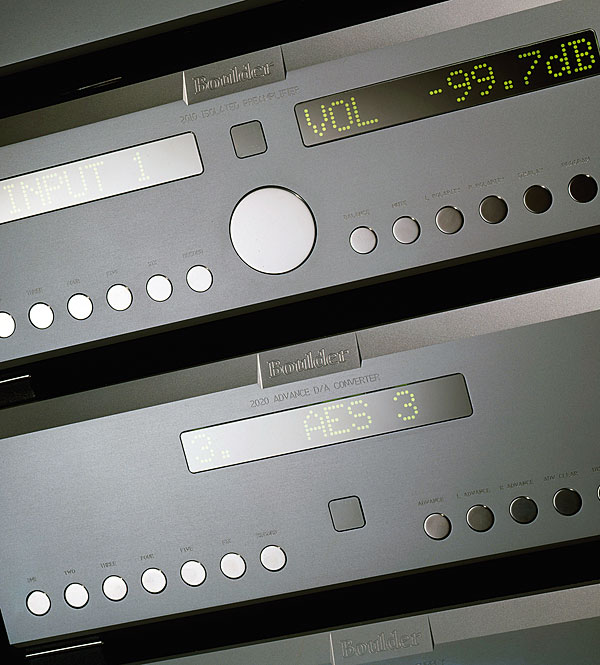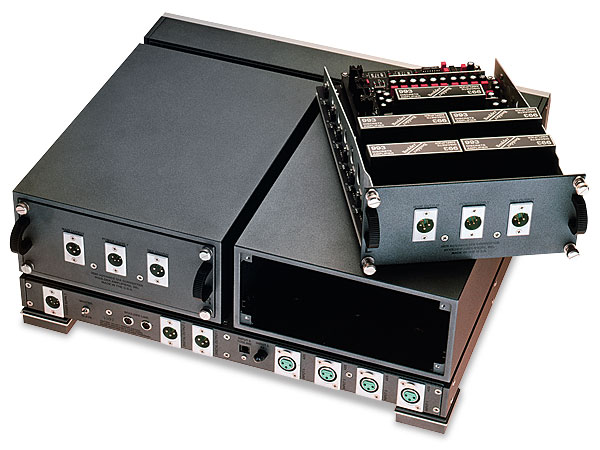Rolling Boulders Page 2
Conclusion
This very costly DAC is built to superb standards of engineering and finish. With the remote control of inputs and outputs, it forms a digital system control centre, augmented by the interchannel time delay feature. While the sound quality did not fully equal the state of the art in digital replay, it nonetheless sets a high standard. As regards value for money, at this price level I find such notions are meaningless.

Boulder 2010 Preamp
Boulder has turned the design of this line amplifier into something of an art form, again incorporating its top-of-the-line discrete amplifier module, the 993, this type including direct coupling with servo offset control. High ±24V power rails guarantee ample headroom. The balanced input impedance is high, affording minimal source loading. Independent listen and record paths are present and unusually, are fully buffered. Interestingly, the 'record' path has 12dB of forward gain, with two outputs, and is fully balanced throughout. This uses a total of four 993s per record channel.
Keeping microprocessor noise out of the audio chain, the logic commands are buffered by opto- isolators. Input signals meet a fully balanced differential input which is then summed at a 993, delivering a single-ended signal to the solid- state, switched volume control. This comprises the 0.1dB and 8dB 'L' attenuator sections operating at low impedance and thus low noise.

These combinations are further interpolated with 16x 0.5dB steps, achieved by controlling the negative feedback and hence the gain of the preceding stage. This amounts to 8dB of variation – a relatively low proportion of the available gain. A pair of following 993s operate as a balanced output buffer of low impedance (50ohm per unbalanced leg). There's no significant bandwidth-limiting in the system, while the double-mono construction assures extremely high channel separation. Triple PSUs deliver left, right and microprocessor power
![]() 2010 Sound Quality
2010 Sound Quality
As might be expected, there was a family resemblance between the 2010 preamplifier and the 2020 decoder, and they proved highly compatible. As active balanced preamplifiers go, this one was just about as good as you can get, comparing very favourably with all the contenders from Krell, ML, Jeff Rowland and Audio Research. In certain systems I have heard better from unbalanced designs, but this is a separate issue; the balanced domain has its own criteria to satisfy, notably zero hum, low noise, high dynamic range and an excellent consistency when it comes to input and output matching.

For a balance line stage, the Boulder 2010 produced a record sound quality score on my personal listening scale and like the decoder it sounded supremely controlled, focused and precise. Quality and subtlety were present over the entire frequency range while coloration was very low, the sound showing no perceptible solid-state vices, such as grain or glare.
Class Act
On tonal balance, it was nicely pitched, being neither too bright nor too rich. Neutrality was the name of the game here, this preamp delivering fine stage depth and width, natural perspective layering and very good focus. This stability and consistency would appear to be associated with the pure and distortion-free sound we heard.

In the bass the amp proved itself to be crisply detailed and highly informative of the character of the instrument concerned. It barely altered the quality of the source in the treble, with near holographic localisation heard here. Like the 2020 DAC, it had a measured pace that was less than upbeat, with dynamics that were thought to be a little shaded and a touch 'quiet'. Boulder's message seems to be one of considered understatement rather than a lively exuberance.
While I personally prefer a presentation that has more 'get up and go', the generally high quality of this sound here was undeniable. Not only was it clearly in the audiophile class, but comfortably in the company of top performers.
Conclusion
Technically, this preamplifier is about as perfect as you can get. Noise and distortion are negligible under all conditions and are maintained over a wide range of loading. It worked flawlessly, the sound was highly neutral, accurate and revealing. In fact, it is the best balanced-mode preamplifier I've so far reviewed. Against the very high cost may be set the superb build, jewel-like finish, high versatility, upgradeability and high performance. In many respects the 2010 is a true work of reference.
























































